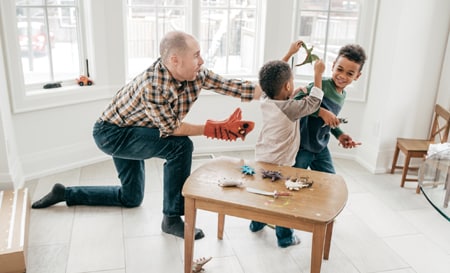What is Time-Out?

Time-out is when your child is removed from where the misbehavior happened. Your child is away from all things that are fun. She does not get any attention in time-out. She cannot interact with her parents or anyone else. Time-out is boring. Time-out works to change problem behaviors because children don’t usually like to be bored.
Time-out is not used for all misbehaviors. Some behaviors like crying or whining can be ignored. Distracting your child with a toy or a song can help prevent or stop misbehavior. Behaviors that cannot be ignored or redirected with distraction should be followed by a consequence that will stop the misbehavior. Delay or removal of privileges and time-out can be used to stop misbehavior.
When Should Time-Out Be Used?
When your child misbehaves, you can use a consequence of your choice. For toddlers and preschoolers, it is a good idea to try distraction and redirection first. If that doesn’t work, you can consider other discipline strategies, like removing an activity or toy your child likes. There are 4 times when time-out may be a good choice:
-
Your child does something dangerous, like running in the street.
A time-out in this situation gives your child a clear understanding that these behaviors are never okay. -
Your child does something harmful, like hurting another child.
A time-out can help your child see that hurting others is never okay. -
Your child breaks a family rule.
Because children know it is the consequence, a time-out warning is not used. Remember that family rules are for those misbehaviors that are never okay. Make sure your child knows the family rules and understands that breaking the rules will mean a time-out. -
Your child does not follow your direction after a warning.
Your child is more likely to follow your directions if she gets praise for following directions or consequences for not following the direction. A time-out warning can help your child do as you directed. If your child does not follow your directions after one warning, time-out may be a good consequence. The time-out warning is described below.
The Time-Out Warning
When your child doesn’t follow your directions give a time-out warning. The time-out warning needs to be stated clearly, simply, and as a statement (not as a question). State this warning in a neutral tone and follow through with the time-out every time if your child does not do as you directed.
For example, look at when the parent decides to use a time-out warning based on her daughter’s response.
“It’s almost time for dinner. Please put your toys away.” (Parent pauses for a few seconds and child continues to play.) The parent says to her daughter, “If you don’t put away your toys, you will have to go to time-out.” (This is the time-out warning.) The parent pauses for a few more seconds to allow the child time to follow directions. The child begins to comply. After the child has finished picking up her toys, the parent says, “Thanks for listening and putting your toys away.”
“It’s almost time for dinner. Please put your toys away.” (Parent pauses for a few seconds and child continues to play.) The parent says to her daughter, “If you don’t put away your toys, you will have to go to time-out.” (This is the time-out warning.) The parent pauses for a few more seconds to allow the child time to follow directions. The child continues playing. The parent says, “You did not pick up your toys so you have to go to time-out.” The parent takes her daughter to the time-out chair and says, “Stay here until I tell you to get up.”
Only give the time-out warning one time. After time-out, the child needs to do what you directed. If she refuses again, she goes back to time-out. The time-out process can go on for a while the first couple of times you use it. Your child will eventually learn that you mean what you say and the time-outs will get easier.
Tips for Time-Out
- Explain time-out or show it to your child in a way she can understand. Showing your child exactly what to do when you give a time-out can help the time-out go smoothly and be more likely to work. You may need to show your child several times so she can remember.
- Practice time-out with your child when you are both in a good mood. Then, have your child tell you what happens during time-out. By doing this, you can be sure she understands.
- Make sure your child knows what behavior leads to a time-out. For example, when you create a list of family rules, let your child know time-out is the consequence if the rule is broken.
- Tell your child where time-outs will happen. Let your child know the rules and steps for time-out.
- Use time-out the same way every time. When the steps of time-out are predictable, time-outs are more likely to help improve your child’s misbehavior.
- Focus on one misbehavior first. When you first start using time-out, focus on a single misbehavior you would like to stop, such as biting.
- Time-out should happen immediately after the misbehavior. The faster time-out happens, the more likely your child will know that her behavior led to the time-out.
- Do not threaten your child with a time-out. If you forget to follow through, your child may not believe you are serious about time-out. If you want to use a time-out to stop misbehavior, it is best to use it immediately after the misbehavior.